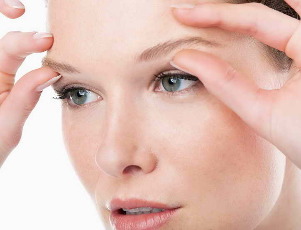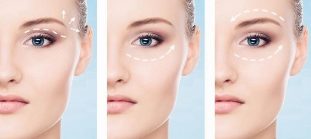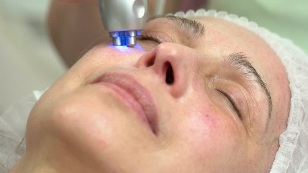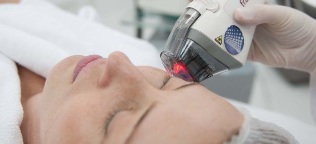
The purpose of eyelid lift hardware, injection and manual manipulations is to rejuvenate and modeling the periorbital area (the area around the eye). This part of the face is considered an area of increased sensitivity. , So even for highly qualified specialists with vast experience, non-surgical aesthetic eyelid correction is a difficult task. Microsurgical cosmetology and aesthetic medicine today offer many effective methods of lifting the eyelids: radio wave lifting, bio-reinforcement with threads, contour plastics. , Photoregression, microcontract therapy. You can choose the most appropriate technique only after a visual examination of the problem area, study the patient's medical history, its goals and thoughts about what the end result should be.
Periorbital lifting feature
The area of the eyelids, also called the periorbital zone (which is not entirely true, since the lacrimal apparatus, the palate fissure and the conjunctival sac, also belong to the periorbital space, in addition to the eyelids), with a thin layer. One of a sensitive body with a thin body. The fat under the skin. The eyelids are musculocutaneous wrinkles, which are bound backwards by conjunctival and cartilaginous tissue. They are located around the eye and perform many functions simultaneously. They do: They protect the cornea and retina from the negative effects of environmental factors (ultraviolet radiation, dust, etc. ), clean the connective tissue membrane due to continuous wetting with tear fluid,
The skin of the eyelid area is several times thinner than other parts of the face, so it is more prone to age-related and stressful changes, which become noticeable after 30 years in most peopleAt this age, the body's natural dehydration process begins, as a result of which epidermal cells lose moisture, and the skin loses its elasticity, becoming loose and flaccid. The periorbital zone is the first signs of aging: hypodynamic folds, mimic wrinkles, decreases in the outer corners of the eyes ("crow's feet").
An eyelid lift is a complex task that should only be performed by a highly qualified physician with excellent knowledge of the topographic anatomy of the eye, as improper actions can lead not only to new defects, but also to the organs of vision. Can also severely affect function. The fact is that eyelids are involved in the construction of the eye focus and optical geometry of the cornea, as well as in the regulation of intrauterine pressure, therefore, improperly performed plasticSurgery and lifting can provoke a disorder of visual function (in some cases, irreversible).
who needs eyelashes
There is no strict medical indication of periorbital zone lifting (other than surgical correction, which is often used to treat pathologies that interfere with the normal functioning of the organs of vision) and commonly visible aesthetic deficiencies. To eliminate is performed at the patient's request. Cosmetologists and plastic surgeons include the following defects for such damage:
- strong overhang of the supraorbital fold;
- extra skin in infraorbital musculocutaneous folds;
- fall outer corners of eyes;
- periorbital protrusions (fatty hernias);
- periorbital edema (sac);
- vascular malformation leading to the appearance of rashes and dark circles under the eyes;
- hypodynamic wrinkles;
- "crow's feet" (decreases in corners of eyes);
- strongly pronounced inforbital grooves;
- "aging eyelid" (suppleness and looseness of eyelid skin).
Eyelid lift also helps to correct overhanging skin and periorbital fat bags and make the look new and more open by improving the overall tone of the area. The timely use of various methods to rejuvenate the area around the eyes helps to solve one of the main functions of periorbital lifting - to hide age-related changes in the skin and of epidermal cells. Relieve visual defects of the biological aging characteristic of the dermis against the background of decreased functional capacity.
The timely use of various methods to rejuvenate the area around the eyes helps to solve one of the main functions of periorbital lifting - to hide age-related changes in the skin and of epidermal cells. Relieve visual defects of the biological aging characteristic of the dermis against the background of decreased functional capacity.
Important! Aging and heavy eyelids are a serious aesthetic defect that can ruin even a young and attractive face. In some, signs of skin aging in this area may appear before the age of thirty (for example, In a person with low weight or endocrine system deformity). As a rule, cosmetics are ineffective to correct current problems and are only suitable to prevent premature aging, so the only one to deal with this defectThe effective method is periorbital lifting.
eyelid lift surgery
An operation to lift the skin in the upper and lower eyelids is called blepharoplasty. It is a type of radical lifting of the periorbital zone, in which tightening and complete removal of excess skin and fatty hernia in the eyelid area. The effect of rejuvenation is achieved. Unlike non-surgical methods of lifting the eyelids, blepharoplasty allows not only to heal aging skin defects and improve the appearance of the area, but to correct the shape and shape of the eyes, As well as relieves various deformities.
Unlike non-surgical methods of lifting the eyelids, blepharoplasty allows not only to heal aging skin defects and improve the appearance of the area, but to correct the shape and shape of the eyes, As well as relieves various deformities.
Blepharoplasty is effective for such serious eye diseases, such as entropion (eyelid blinking and eyelid side eyelid) or exophthalmos (displacement of eyeball outside the orbit). In total, blepharoplasty consists of three typesAre: upper, lower and rounded.
Table. Types of radical periorbital lifting
| operation type | section area | can the deformation be corrected |
|---|---|---|
| supraobital blepharoplasty | A skin incision that is made along the orbital or lateral septum of the upper eyelid. | Removal of excess skin, subcutaneous fat and muscle plastic. |
| suborbital blepharoplasty | A transcutaneous or subciliary incision is made. | Removal of periorbital edema, bags under eyes, fatty hernia. |
| circular blepharoplasty | eyelid surgery on both sides. | Solving problems for all types of blepharoplasty. |
The periorbital zone operation is strictly performed in a hospital setting, except for the possibility of an external field procedure. The patient is given general anesthesia, and the duration of intervention is, on average, about 3 hours. A significant disadvantage of the method is the postoperative period, however, characterized by its short duration (approximately two weeks), the need for painkillers, regular dressings, and antiseptic treatment, and significant restrictions on governance and professional activities.
Important! The benefit of surgical blepharoplasty is not only the ability to tighten the skin of the eyelids, but also to perform plastic surgery of muscle tissue, which cannot be achieved using hardware and other minimally invasive methods.
Periorbital zone tightening without surgery
Surgical eyelid lift is a highly effective method of radical rejuvenation of the area around the eyes, but only for older age groups (after 40 years) with signs of skin changes related to specialist aging and deep age. It is advisable for patients to resort to this. Before reaching this age, while the hydrodynamics of the tissues are within normal limits, there are many less painful ways of correcting existing problems, while in some cases most of these techniquesThe effectiveness can be compared to the result of surgical plasticity.
injection (contour) plastic
Contour plastic is the safest way to tighten the skin of non-surgical eyelids, according to the technique it relates to mesotherapeutic procedures. Contouring is a subdermal injection of specialized implants called fillers.
These are preparations in the form of a homogeneous and viscous suspension or gel based on the components that have a high degree of affinity for the body's own tissues. These can be:
- hyaluronic acid;
- calcium hydroxyapatite;
- collagen (a peptide synthesized by fibroblasts and one of the main elements of the external substances of the dermis, which ensures its elasticity and elasticity);
- polymers based on acrylic and methaceletic acid;
- high molecular weight oxygenated silicon;
- polylactic acid;
- tripolphosphoric acid salts, etc.
The most popular and sought-after filler for periorbital lifting are preparations based on hyaluronic acid. These are biodegradable (absorbent) dermal implants that not only compensate for tissue loss in the region, but also in eliminating wrinkles. Help - One of the main visual signs of facial aging. The advantages of hyaluronic fillers include high hypoallergenicity and excellent results, which can be appreciated immediately after implantation. Hyaluronate sustains within several weeks. Post-injection should be repeated.
Biosynthetic implants based on polylactic acid and calcium hydroxyapatite retain their properties for 1-2 years.
RF-lifting
Radio wave or radiofrequency lifting is a non-surgical procedure to lift the area around the eyes with a high degree of effectiveness. Among hardware techniques for minimally invasive lifting of the skin of the upper and lower eyelids, RF-lifting takes the lead, as it allows not only to achieve immediate tightening effect, but also to position the skin in the periorbital zoneMakes significant improvements in.
Among hardware techniques for minimally invasive lifting of the skin of the upper and lower eyelids, RF-lifting takes the lead, as it allows not only to achieve immediate tightening effect, but also to position the skin in the periorbital zoneMakes significant improvements in.
Radio waves penetrate to the required depth in the dermis, heating the epidermal cells to a collagen densification temperature, which is about 60 ° C. Under the influence of thermal energy, the dermal tissue heats up, a collagen structure. Partial reversal occurs, resulting in the loose collagen fibers being re-compacted and their characteristic take on the spiral shape, which is the lifting effect.
RF-lifting is suitable for correcting all age-related problems in the area around the eyes (crow's feet, hypodynamic wrinkles, eyelid putosis, etc. ), and the results obtained last for 1-2 years. To get a stable rejuvenation effect, you will need to do about 6-10 procedures with an interval of at least 7-10 days.
bio reinforcement with thread (thread lifting)
Thread lifting is a process to rejuvenate the area around the eyes, based on the implantation of special cosmetic threads made of various metals and synthetic materials under the skin, resulting in a new one in the subdermal layers. The collagen structure is formed. The procedure is quite effective and allows you to deal with the problem of "aging eyelid", fatty periorbital hernias, the occurrence of gravitational ptosis and other skin aging phenomena.
There are many types of threads for lifting threads. In cosmetology, threads made of precious metals are in great demand. These threads are made of platinum or gold and are designed to strengthen the upper layers of the dermis. Threads not only provide a visible lifting effect, but also stimulate cellular metabolism, improving the supply of nutrients, oxygen, and vitamins to the dermal cells. Severe damage to threads made from precious metals leads to high risk of detachment andThere is an impossibility to use many cosmetic procedures, for example, photothermolysis after reinforcement.
Liquid mesothreads are primarily used to withstand small hypodynamic folds, correct the "aging eyelid" and lubricate the skin in the periorbital zone. The duration of such a procedure is 20-30 minutes. Not high, but there are many differences in reinforcement with liquid threads and always with different side effects (swelling, bruising, redness). Experts believe that the most effective type of eyelid thread lifting is Swiss, Polylactic, and Korean. There are threads. After such reinforcement the result lasts for about 2-3 years.
Partial Photothermolysis
Fractional photothermolysis is another effective method of tightening the skin of non-surgical upper and lower eyelids. It is a type of laser rejuvenation in which the use of a fractional laser generator (eg, an erbium laser) affects the problem area. The beam generated from this device is shattered into multiple currents and, when it hits the skin, forms a large number of finely treated areas, with the main effect being the surrounding The tissues are not heated nor injured.
The tissues are not heated nor injured.
A distinguishing feature and at the same time the main principle of the action of fractional photothermolysis is heating the skin to a temperature of 250–300 ° C, which the experts call the evaporation process. Under the influence of this temperature, chronic, pathologicallyThe transformed and destroyed cells are destroyed and evaporated, while natural neocatalysis activates and increases the activity of fibroblasts, which synthesize the main components of the extracellular matrix - peptides (collagen and elastin).
The result of fractional laser resurfacing is noticeable tightening of the skin in the eyelids, reducing and reducing wrinkles, restoring the hydrodynamics of the periorbital tissue and improving the normal state of the skin in the area.
pulse currents (microcurrents)
Microcant therapy refers to less painful methods of eyelid lifting, but a significant disadvantage of this method is the short duration of results (no more than 4 months). Clinical results from the use of microcrack therapy to lift the periorbital zone. The impulse is due to the following properties of currents:
- lymphatic flow normalization.lymphatic drainage effect, which impulse currents on the skin, improves lymph movement, prevents its stagnation and helps to lighten dark circles under the eyes;
- Stimulation of metabolic processes.The activation of cellular metabolism has a positive effect on the transport of oxygen and nutrients and the appearance of the skin (the skin becomes smoother, achieving a healthier appearance);
- Restoration of muscle tone.The muscles of the eyelids are quite weak, and the extra stimulation allows you to get a tightening effect.
The standard course duration is from 10 to 20 procedures, while in most cases the procedure needs to be repeated after a few months.

before and after photos
Conclusion
Eyelid lifting is a difficult, but possible task at the same time, for which modern aesthetic medicine offers a large number of effective methods, including less painful manipulations with less chance of complications. After talking, diagnosing the problem area, and studying medical history data, it has been decided individually which method of lifting the periorbital would be most effective and safe.
Surgical techniques are mainly used for patients with obvious signs of aging in the area around the eye, in which the use of gentle techniques is ineffective and will probably not give a stable positive result. And it is preferable for individuals with early manifestations of the "century of aging" to choose minimally invasive methods with shorter recovery periods.
























































